19 September
Conferences
ON THE 125TH ANNIVERSARY OF THE DEATH OF JULIÁN GAYARRE
"Marble and bronze for immortality". The Gayarre Mausoleum, by Mariano Benlliure
Mr. José Javier Azanza López
Chair of Navarrese Heritage and Art
On 2 January 1890, Julián Gayarre, the tenor with "the voice of an angel", died in Madrid at the age of 45. After a massive funeral procession through the streets of the capital, his body was buried in the Roncal cemetery three days later. It was Gayarre's family, led by his nephew Valentín, who commissioned the sculptor Mariano Benlliure (El Grao, Valencia, 1862-Madrid, 1947) to create a mausoleum to cover the tenor's tomb.
Why Mariano Benlliure? Firstly, because the Valencian sculptor, trained at the Escuela de la Lonja and the Masriera y Campins foundry in Barcelona, was one of the leading representatives of Spanish sculpture of the inter-century period. But mainly because the two men were linked by a close friendship that arose during the Navarrese tenor's visits to Rome to perform his great operatic successes, a friendship of which there are numerous written testimonies.
The process of building the mausoleum in Rome, where Benlliure had his studio, was lengthy and complex. We know that the sculptor had finished the sketch in August 1890 (it is kept in the Museo Nacional del Teatro in Almagro, and there is also a plaster modelof the figure of the Musician in the Salvador Vilaseca Museum in Reus), and in 1891 he had already begun to execute it; however, it was not completed until 1897. What were the reasons for the delay? On several occasions, Benlliure alleged difficulties in receiving materials in order to continue the work. But the main reason for postponing the work was the need to attend to the numerous commissions received from different official institutions and which had a deadlineof submission; such is the case of the monuments to Diego López de Haro (Bilbao, 1890); to the Marquis of Larios (Malaga, 1890); to Lieutenant Jacinto Ruiz (Madrid, 1891); to the Marquis of Santa Cruz (Madrid, 1891); to Isabel la Católica (Granada, 1892); to Lieutenant General Manuel Cassola (Madrid, 1892); to Queen María Cristina de Borbón (Madrid, 1893); to Blessed Juan de Ribera (Valencia, 1895); and to the poet and writer Antonio Trueba (Bilbao, 1895).
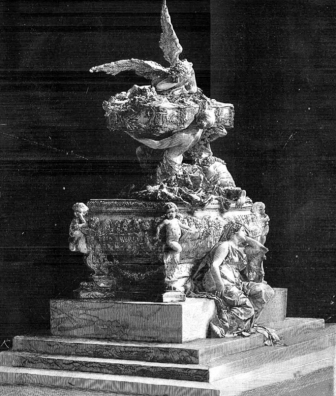
Sketch of Gayarre's mausoleum
La Ilustración Española y Americana, X
With the accumulated delay, the sculpture was finished in 1897, but it was not installed in the Navarrese cemetery until 1901. The reason for this moratorium lies in the fact that it became a "travelling mausoleum", as Mariano Benlliure, proud of his work, understood that it was a good cardof presentationof his artistic qualities, so he obtained permission from the family to exhibit it in different art exhibitions and salons. exhibitionIt was present at the 6th Biennial of the Círculo de Bellas Artes, held in 1898 at the Palacio de Cristal del Retiro in Madrid, where it was highly praised: "Poem of marble and bronze, whose beauty of detail is unparalleled issue"(El Imparcial, 28-5-1898). And in 1900 the mausoleum won the Medal of Honour for Sculpture at the exhibitionUniversal in Paris, held at the Grand Palais, in what Violeta Montoliu, the artist's biographer, describes as "a total triumph". After this success, the mausoleum was moved to Madrid, where the Queen Regent María Cristina showed interest in installing it at placeof Isabel II, opposite the Teatro Real; but the tenor's family insisted on moving it to Roncal, where it arrived in 1901.
Gayarre's mausoleum was placed in the Roncal cemetery in mid-July 1901, according to the brief news published in El Pensamiento Navarro. It was Benlliure himself who supervised its installation, experiencing moments of deep nostalgia at the moment of parting with his creation in the Pyrenean village, where, in his opinion, it was not going to have the significance it deserved: "You cannot imagine the great sorrow it causes me to have to confine in such a completely deserted valley one of my most beloved works, the one I have most enthusiastically created to immortalise such an exceptional loved one as Gayarre...", he confessed to his friend the liberal deputy from Granada, Natalio Rivas, in a letter written in Pamplona on 22 August 1901.
The official inauguration of the monument took place on 1 October 1901. sampleA good example of the affection he had for Gayarre, and of the importance he attached to his work, is the fact that Mariano Benlliure was personally responsible for cleaning the mausoleum for decades, a task he shared with his disciple Fructuoso Orduna and which the latter undertook alone after Benlliure's death in 1947. After Orduna's death in 1973, the ensemble began a phase of degradation that led to successive restorations in 1989-90, 1996 (declared an Asset of Cultural Interest by the Government of Navarre) and 2010.
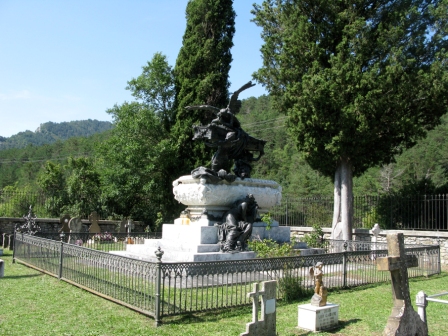
Mausoleum of Julián Gayarre in the Roncal Cemetery
Focusing our interest on its composition and iconography, the mausoleum consists of two distinct bodies. The lower one, made of white Carrara marble, rests on a staircase and simulates a false sarcophagus profusely decorated with singing children carrying phylacteries with the names of Gayarre's most successful operas, garlands and bucklers.
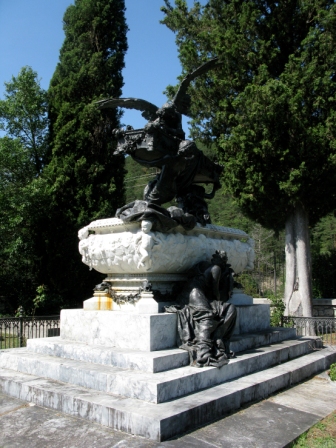
Mausoleum of Julián Gayarre
On one side is the beautiful figure of Music, broken with grief, slumped on the steps and resting her head on the sarcophagus, hiding her face. On the opposite side, an opera curtain hangs to the ground, symbolically falling after the last performance, and on its border we can read the names of Donizetti and Rossini, whose compositions the tenor from Roncal performed.
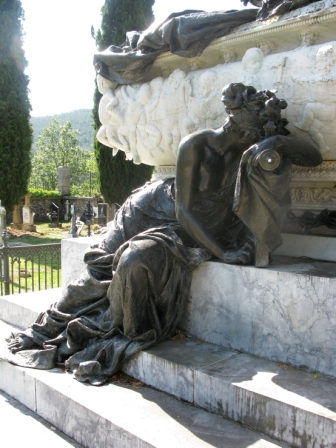
Allegory of Music, mourning the death of the Roncal tenor
The static composition of the lower body contrasts with the greater dynamism that Benlliure gives to the upper part, cast in brass, where the allegorical figures of Harmony and Melody raise in their hands the figurative coffin of the tenor, decorated with bas-reliefs of putti, floral groups and musical motifs, which accompany the registration: "Julián Gayarre 1890". On the sarcophagus, the genius of Fame leans his head close to the coffin, in an attempt to continue listening to "the voice of an angel", a psychological detail of great success for the beautiful nickname by which Gayarre was known. The sculptor's technical mastery is evident in the work, a skilful interpreter of a language that combines classicism, Renaissance sculpture, late romanticism and modernism.
The Mausoleum of Julián Gayarre marks the beginning of funerary sculpture in Benlliure's production, based on a double premise: first, of the total of twenty-one funerary monuments recorded by V. Montoliu, the earliest is the Mausoleum of Julián Gayarre. Montoliu, the earliest is that of the tenor from Roncal; secondly, it is the only one in which the deceased does not appear in effigy (either in relief or in round figures), as its meaning was entrusted to symbolism, as the sculptor himself stated: "it is the only work in which the portrait does not appear, everything is said by the figures". Analysis of the funerary monuments of Práxedes Mateo Sagasta (Madrid, 1905), the Viscountess of Termens (Cabra, Córdoba, 1914), the bullfighter Joselito (Seville, 1925), Eduardo Dato (Madrid, 1928), Vicente Blasco Ibáñez (Valencia, 1935) and the tenor Francisco Viñas (Barcelona, 1943), allows us to establish some of the most important examples, 1943), allow us to establish some points of contactwith the Roncal mausoleum, such as the combination of materials, the decorative presence of classicist roots, the symbolic language resource, the children's topicor the reclining arrangement of the figures. It can also be related to funerary monuments by other sculptors of the period, such as Pedro Estany and Agustín Querol.
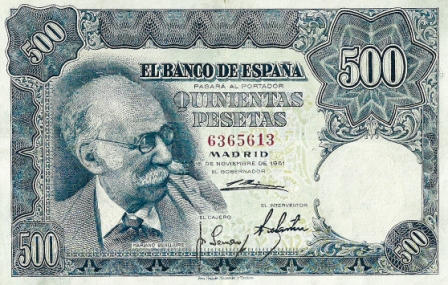
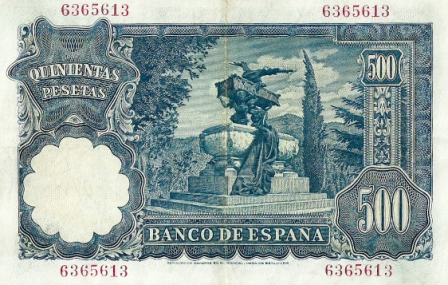
Obverse and reverse of the 500 peseta banknote issued in 1951
Finally, as a curiosity, we should note that Mariano Benlliure made another "mausoleum" for Navarre, albeit a much smaller one. We are referring to the monument commissioned by the Countess of Vega del Pozo, María Diega Desmaissières y Sevillano y López de Dicastillo (Madrid, 1852-Bordeaux, 1916) for the gardens of her palace in Dicastillo at reportfor her little dog Merlin, to whom she was particularly fond. Old photographs show its execution in white Carrara marble on a stepped base, decorated with bucráneos and plant motifs, to which were added two doves in the curved pediment of the crowning; and the presence of the dog was not lacking in a side projecting as a parapet.
